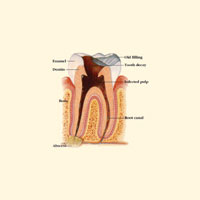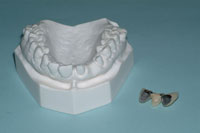The Internet is changing the way we practice; we get more information and we give more information. In this manner, I have found the World Wide Web has also become a regular source of new patients. My team members and I frequently get requests for information from potential patients from various locations, and with careful nurturing, many of these potential patients can become real patients. And because they’ve typically researched their needs and possible solutions, they are frequently the best patients.
 |
 |
| Figures 1 and 2. The patient presented with a complaint that her relatively new upper denture did not fit well or look good. |
Bonita, my front desk person, received a detailed e-mail from a 56-year-old high-level female business executive who found our practice through denturewearers.com. She had been wearing dentures since she was 19 years old, and in all that time, she never liked her smile. She wanted “to have a beautiful smile for the first time in 37 years.” Her chief complaint was that her relatively new upper denture did not fit well or look good (Figures 1 and 2). She had undergone a bone graft in the year prior to this denture being made and was planning on having a new implant-supported denture in the near future. She had experienced a delay in scheduling this treatment, as her insurance company changed and the new insurer had denied coverage for the implant. However, in the meantime, this new denture was causing her severe discomfort and anxiety, as well as embarrassment. She felt that the denture gave her a “droopy profile” that was “not flattering” to her face, and the denture made her look like she had “an overbite” (Figure 3).
 |
 |
|
Figure 3. The patient’s denture gave her the appearance of having an overbite. |
Figure 4. The position of the patient’s mandible that was most comfortable was more forward and down. |
Her oral surgeon and the former dentist “were paid in full” and were aware that she was changing dentists to get that “beautiful smile,” especially before the implants were done. To make matters worse, it was already the middle of November, and she dreaded going to her company Christmas party in early December with “ugly teeth.” Because she had just finished paying for this denture, she was very concerned about the cost of another new denture. She did not want to have a payment plan that would accrue interest, and she could not afford to pay in full at the time of treatment.
Obviously, this case would be a challenge for many reasons. She was a new patient from the Internet, not a referral from another patient or friend. We had no doctor-patient relationship or history, and there was no guarantee of commitment to continue care. There were possible philosophical and ethical considerations; after all, she was changing dentists during the course of treatment. Finances were also a problem because she had already spent a fair amount of money. We knew we would need to find comfortable payment options, and we had to do all this before the Christmas party. We asked ourselves, “Can we help her?” The answer, “Of course!” We try our best to reasonably accommodate all of our patients. Each relationship requires special care, and everyone is special and needs to be treated to feel that way. In my practice, the answer is yes, now what’s the question?
First, we try to make financial arrangements easy, even before the patient calls for an appointment. You simply cannot play if you cannot pay. That is why the CareCredit patient payment program is featured prominently on denturewearers.com as well as on my Web site, lorinberland.com. This makes it easy and accessible for the patient to fill out an application online, in private, by simply clicking on the link. Because she applied online, this patient was approved before she ever stepped into my practice. In fact, she e-mailed me her entire dental history as well as the denture questionnaire from denturewearers.com before we ever met. This really helps when you first meet a new patient, especially a new denture patient. Knowledge is power.
The other key factor in managing financial arrangements is to understand that the patient may have family members who will significantly influence his or her decision on a major purchase. Originally, our patient stated, “I’m not sure what to do…I’m pretty sure my husband will say no to spending that much for a denture I won’t wear more than a year.”
However, after meeting with our team and taking the treatment plan home, she contacted us, stating, “My hubby said to get the denture. He feels it’s better to spend the money now on a really good one, rather than to spend it later repairing damage to my mouth caused by the ill-fitting one.” By either including the spouse in the treatment consultation, or providing the patient with the education needed to explain the benefits to his or her family, you increase your chances of the case moving forward. At her initial visit, thanks to Care-Credit, the patient was prepared to pay in full, and she did so gladly.
We pay special attention to new patients, and we think her comments via e-mail after her appointment reflect our practice philosophy: “I can’t even begin to tell you what yesterday meant to me. There simply aren’t words good enough. Every one of you is an absolute delight!! Your ‘family’ is so kind, understanding, and patient. For the first time in my life, I actually enjoyed a visit to the dentist and I am so looking forward to my next visit…something I never in my life dreamed I would say!”
She even chose the smile design for the shape and length of the upper 6 front teeth from the Lorin Library (R-2, L-2: round canines, square round laterals, and long square centrals), all on the Web site. She definitely did her homework. We then used the TENSing technique I learned at Las Vegas Institute to find the neuromuscular position of her mandible that was most comfortable for her, physically as well as aesthetically. Form does follow function. In this case, it was more forward and down (Figure 4).
 |
 |
|
Figures 5 and 6. The existing denture was duplicated with PVS putty and bis-acryl. |
 |
|
Figure 7. Wax try-in. |
 |
 |
 |
|
Figures 8 to 10. The final denture provided a more full, natural, and attractive smile. |
We recorded her favored bite position with a PVS bite registration material. My assistant duplicated the existing denture with PVS putty and bis-acryl (Figures 5 and 6). We took careful notes and photos of what she did and did not like about the denture. Then we lined the duplicate with PVS light-body regular set to get a more accurate impression of the soft tissue. With all this information gathered from the duplicate of her unsatisfactory denture, (ie, gumline, teeth length, shape, arch form and alignment, PVS impression, and bite registration), as well as her observations and comments, we were in a much better place for the next appointment, the wax try-in. Before she left, we lined the existing denture with a tissue conditioner. This gives patients a tighter fit that they love. Also, a good tissue conditioner will reduce inflammation in the edentulous areas to give us a better final impression at the next visit. She left the appointment with a better-fitting denture and on the way to healthier gums.
A few days later, the wax try-in went perfectly (Figure 7). We took another light-body PVS impression inside the plate and another bite registration. A denture cannot be too tight or the bite too good. From there, the denture was made to her complete satisfaction. Figures 8, 9, and 10 illustrate perfectly the fuller, more natural, and attractive smile. In the coming year, we will be using this denture to plan for an implant-supported denture.
CONCLUSION
The Internet has provided a powerful communications tool that can help bring new patients to the dental practice. The case described in this article demonstrates how the Internet, combined with creative financial arrangements and a caring attitude on the part of the dentist and staff, can convert potential problem patients to perfect patients.
Dr. Berland is both accredited by and a Fellow of the American Academy of Cosmetic Dentistry. He is one of the most sought after speakers and published authors on cosmetic dentistry in America. He has been featured in national and regional magazines, major dental journals, and recently NBC News, Fox News, and ABC’s 20/20. For more information on denturewearers.com, The Lorin Library Smile Style Guide, and/or the 8-AGD credit DVD “A Full Mouth Rehab in Two Appointments,” call (214) 999-0110 or visit dallasdentalspa.com.
Disclosure: Dr. Berland is the developer of the Lorin Library.











